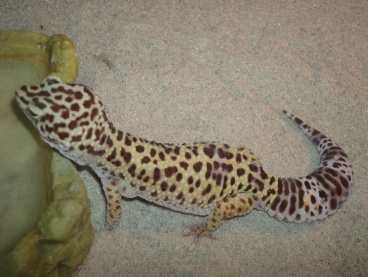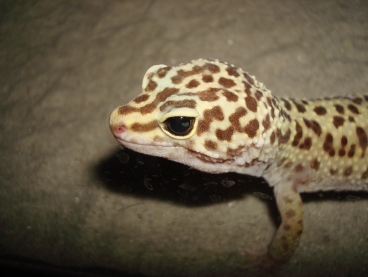Leopard Gecko Care
When it comes to popular species, there’s little disagreement that the Leopard Gecko Eublepharis macularius has now long been the flagship for anyone wanting to get into the herpetoculture trade as either a breeder or a hobbyist. There is no doubt the Leopard Geckos became so popular in large part due to their gentle disposition towards handling, and their ease of breeding. This of course was not always the case and changed quickly when herpetoculturists discovered the genetics could be relatively easily manipulated, as could sex determination. Next thing you know, there is a Leopard Gecko population explosion which inevitably dropped the prices rapidly and made the Leopard Gecko Eublepharis macularius the new “easy-to-get” reptile for the herpetological trade on a whole. This opened the door for many new hobbyists and keepers alike.
Their care requirements being seen as rudimentary allowed these new pets to enter into  many classrooms and children’s bedrooms, without the fear associated with the now infamous salmonella scare of turtles or snake bites. The misinformation, so easily broadcast by the mass media, furthered the gap between herpetoculture and the public-at-large. I will save that diatribe for another piece.
many classrooms and children’s bedrooms, without the fear associated with the now infamous salmonella scare of turtles or snake bites. The misinformation, so easily broadcast by the mass media, furthered the gap between herpetoculture and the public-at-large. I will save that diatribe for another piece.
To my knowledge, all of the Leopard Geckos offered for sale today are what are known as “captive-bred.” This is a benefit to all keepers, as this means there’s no concern about any bacteria or other such infestations associated with captive-born or wild-caught animals.
The fact that wild populations are no longer impacted by collection practices is vital.
Captive care of Leopard Geckos can be considered one of the “easier” reptile species to care for, when comparing care requirements of other species offered for sale. I’m hesitant to use the word ‘easier,’ as it can and does lead to a false sense of being able to purchase a Leopard Gecko, place it in an enclosure, and have it live as it normally would while feeding it once a week. I’ve said this before and I will reiterate the same here.
Reptiles are not, and should never be considered a disposable pet. No pet for that matter should ever be considered “disposable.”
The very first thing you should do as a potential owner is what you are already doing here. Read not just this article/post, but as much information as you can possibly get your hands on. While I may be an authority on reptiles, I do encourage you to seek out other sources of information. There’s no such thing as too much information when it comes to the captive care of reptiles.
Once your research is done, I would go and buy all of the equipment and appliances needed to set-up your new pet’s home, and have it running for a few days prior to bringing your new gecko home.
Leopard Gecko Captive Environment
The biggest consideration you have to make with all Leopard Geckos, besides the color/morph you want, is the enclosure. There are both reptile and fish tanks that can provide a place to keep your new pet. Reptile enclosures typically come with some type of lid or sliding screen; fish tanks are generally open. The reptile enclosures are generally more expensive, which is why I go with a fish tank and add my own screen top of appropriate size, and clips to hold it into place (and keep out the cats I own). If you own no other pets or have children old enough, you don’t even have to put a lid on it, as long as you don’t give the Leopard Gecko a climbing branch or décor they could use to escape.
You will also need a heating element of some type to serve as a basking spot. This should raise the ambient temperature to about 85˚ and the basking spot to 90˚. I like ceramic heat emitters and use the domes with ceramic housing. It’s likely that if you use plastic, the plastic will melt due to the high heat output. You will also need a hide box the Leopard Gecko will be able to go into and feel safe and secure when not roaming the enclosure. I usually go with the rock-type, which is actually molded plastic. This is placed about halfway under the heating element, but you can also purchase two hides and place them at alternate ends of the enclosure. This will allow the Leopard Gecko to choose the proper temperature when thermoregulating itself.
The next important piece is that of substrate, or the material which will cover the bottom of the enclosure. There are a multitude of reasons why people select a particular substrate. While they all may have their valid reasons, I tend not to agree with most of them due to personal experience when it comes to raising and breeding Leopard Geckos. I have learned throughout the years, that washed play sand available at major home improvement stores works just fine for juvenile and adult Leopard Geckos. I use the same substrate with my entire collection of desert-dwelling reptile species without any issues.
A water bowl of sufficient size for the Leopard Gecko to crawl into and soak is also needed. Décor can be either plastic or live plants. I go with the plastic, and include a piece of sandblasted grapevine to assist in shedding. It’s interesting to note during the shedding process known as “ecdysis,” they will eat their shed skin, presumably to recapture lost nutrients.
Feeding
When it comes to feeding, Leopard Geckos will eagerly consume most types of insect fare being offered. The typical foods include crickets and mealworms of appropriate size, as well as wax worms, which can be fed as an occasional treat. Make sure to check out our incredible Sponsors for all your reptile feeding needs. I will feed no more than the Leopard Gecko can consume within a one-hour time frame. The crickets are dusted with a vitamin and calcium supplement every other feeding.
Maintaining a healthy Leopard Gecko is a matter of simply changing the water daily and sifting out the feces or waste from the enclosure. Once a month the entire enclosure should be dumped, and the décor and enclosure washed with warm water, and the sand replaced.
 Leopard Geckos make an outstanding introductory pet to the wonderful world of herpetoculture. They are easily handled and reasonably priced. I would encourage anyone thinking about owning a reptile as a pet to look into these incredible Geckos as a first pet when it comes to reptiles.
Leopard Geckos make an outstanding introductory pet to the wonderful world of herpetoculture. They are easily handled and reasonably priced. I would encourage anyone thinking about owning a reptile as a pet to look into these incredible Geckos as a first pet when it comes to reptiles.
For a more in-depth look into the wondrous world of the Leopard Gecko care and breeding, I would suggest that you order my book, The Captive Care Prescription for Leopard Geckos. This eBook explains in-depth the many aspects of Leopard Gecko taxonomy, care, breeding, and many other aspects in far more detail than can be covered in one post here.



